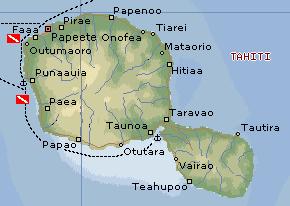
Click the map for a Society Isles overview
|
Pacific Landfalls Fr. Polynesia Pages Related Pages |
Tahiti
 Click the map for a Society Isles overview |
Language: French, Tahitian
Population: 150,000, about 60% Polynesian, 15% European, plus Chinese
and mixed Polynesian/European
Money: French Polynesian Franc (No, not Euros!) US$1 = 93CFP
Landscape: Lush, volcanic, with peaks to over 6,000 feet.
Visited: August 10 to 31, 2003. Then again January 17, 2004 off and on through March 4.
Read about diving in Tahiti, and our time with visitors Karen and Jon and Vince in Tahiti.
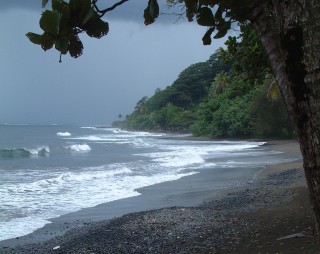 The wild and beautiful north coast of Tahiti |
History: The first Europeans to reach Tahiti itself were the British
captain Samuel Wallis and his crew on HMS Dolphin. In 1767, they
found valleys ruled by different warlike chiefs. Although the natives
initially tried to attack, a taste of firearms convinced them to be friendly.
They traded with the sailors, bringing pigs, poultry, fruit ... and willing women.
Iron was in particularly great demand, and the sailors would pry nails out of the ship to
trade for sex. Captain Wallace was forced to ban all trips ashore except for
food and water. Wallace left after naming Tahiti King George III island and
hoisting the Union Jack. A year later the French explorer Louis-Antoine de
Bougainville arrived and claimed the island for France, unaware of Wallace's visit.
Captain Cook was the first man to really describe Tahiti to
the Europeans. On his four visits between 1769 and 1777, he mapped much of
Polynesia and learned about the area from the locals, such as one high priest
who could name and chart dozens of islands. Cook also brought artists who
captured some of the beauty of Tahiti and the nearby islands.
The HMS Bounty, under Lt. William Bligh, provided an
interesting portion of Tahiti's history with the crew's mutiny after stopping in
Tahiti to pick up breadfruit for transport to the West Indies. The actual mutiny
occurred in Tongan waters, but the mutineers took the ship back to Tahiti. Some
of them left again and settled on Pitcairn island, but others stayed and acted
as mercenaries for the warring chiefs, upsetting the long-standing power balance.
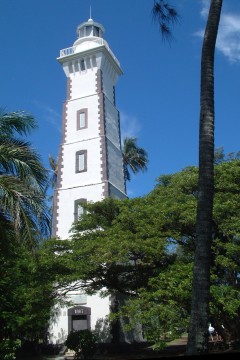 Point Venus lighthouse & monument |
In the late 1700s and early 1800s, Protestant missionaries
from England tried to convert the islands to Christianity. Although initially
unsuccessful, in 1815 the missionaries aided a deposed king, Pomare II, in
regaining Tahiti and allowed the defeated tribes to become Christians instead of
being punished. When King Pomare II, who was never baptized, died in 1821, and
his infant son died a few years later, Queen Pomare IV came to power. Closely
allied to the London Missionary Society, Pomare IV ruled much of modern French
Polynesia for about half a century. Although Catholic priests from France tried
to convert the Polynesians to Catholicism, the Protestant queen expelled them
from Tahiti. When French warships arrived and demanded reparations, their demands
were met but Queen Pomare wrote to England asking for aid. The French continued
to try and gain control of Tahiti and the nearby islands, and while France and
England nearly went to war over the issue, no aid arrived for Tahiti. In 1842,
Tahiti became a French protectorate while the Queen was away, and she was
deported to Raiatea when she returned. Although
the Tahitians resisted for several more years, Queen Pomare eventually realized
no British aid was coming and reluctantly agreed to the French protectorate.
Through the 1800s and early 1900s, trading ships and whalers
from the US and Europe called at Tahiti for supplies and goods such as pearls or
mother-of-pearl and sandalwood. They brought diseases such as smallpox and
venereal disease that the Polynesians had no resistance to. Combined with
firearms and alcohol, the Polynesian population plummeted by about 95%.
Meanwhile, overzealous missionaries clothed the Polynesian women from head to
toe, forbade dancing, imposed strict sexual morality, and destroyed countless
artifacts from Polynesia's former culture. French missionaries attempted to
convert the populace to Catholicism, but only succeeded in the Marquesas (the
rest of French Polynesia remaining mostly Protestant.)
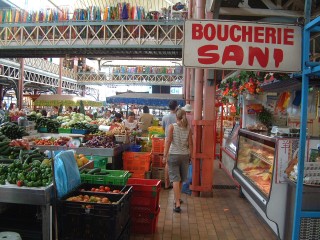 The bustling and colorful Papeete market |
Meanwhile, French control over Tahiti and the nearby islands
slowly increased until, in 1880, Tahiti became an official French colony. For
much of the next century, French Polynesia was ruled by governors appointed in
Paris, and French officials decided everything. The only elected official with
any authority was the mayor of Papeete. When the colony became an Overseas
Territory in 1946, it gained an elected territorial assembly and representation
in French parliament. However, the governors were appointed from Paris until the
1970s.
To read more about French Polynesian history, including some
about the World Wars and French nuclear testing, read the
Tuamotus history.
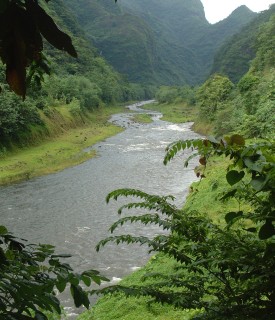 The Papenoo River road provides access to Tahiti's interior |
(Amanda) Interior Tahiti is beautiful. I'll say that
right now, no matter what Papeete looks like. And in my opinion, even Papeete is
a cute not-so-little town that is a culture experience itself. Sure, it was
expensive. But who said you had to eat there? It was good for tourist shopping
(though also expensive) and the local market was a definite must-see. But except
when we had visitors onboard - and I'll admit, that was rather a lot of our time
- we rarely went into Papeete at all. Most of our time was spent anchored out
over beautiful, shallow sand with the crash and boom of waves breaking over the
reef in our ears. It was the first and biggest place of civilization that we had
had in quite a while, and it was a bit of a relief not to have to order ahead
the day before to be able to get a baguette for lunch the next day.
As I said, the interior of Tahiti was beautiful. Lush,
tropical forests covered her towering hills, which were stunning when they
bothered to peek out from their constant cloud-covering. Rugged gravel roads
provided the means of getting to the middle of the island, even though it seemed
like half the time they went through the river instead of beside
it. For many dollars more, you could take the same trip, except pressed into a
jeep with a bunch of other people. And then you actually would be
traveling up the river!
The diving in Tahiti
was pretty good, though maybe that was
because we hadn't done it for so long. I'm not even sure if we would have dived
there, except that Karen & Jon
coming down for a visit gave us a swift kick in the rump into the water.
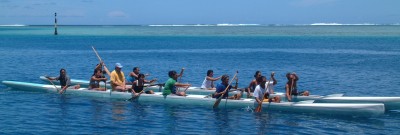 Many paddle teams practiced in Tahiti's calm lagoon |
(Jon) Tahiti was very different from any place we'd been for a long time, mainly by being relatively populated. Its population and physical beauty reminded me of Martinique, but with a huge reef all around it, which made anchoring and diving delightful. This should have been enough for me to really enjoy Tahiti, as I'm very fond of Martinique, but Tahitian prices were nothing short of astronomical which made enjoying it difficult for me. At least there were goods and services available that we hadn't seen for a while. But having to spend over $1,000 to have a couple of minor repairs done to our sails tended to flavor my opinion of the whole place. Perhaps I shouldn't harp on prices, but after South America, where a nice 3-course meal with a glass of fresh fruit juice can be had for about $3, Tahiti, at $20 for a 'plat du jour' and beers at $2 even in a supermarket, was a bit of a shock.
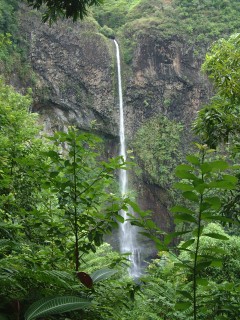 A glorious waterfall in western Tahiti |
My opinion of why the prices are so high is because the
French feel guilty about their treatment of the French Polynesians much as the
US feels guilty of their treatment of the American Indians. The French (&
the US) were pretty high-handed in their relocation of islanders so they could carry out
their atomic bomb testing, so (in fine American fashion) the French throw $$ at the
problem. Money poured in while they were doing their testing, either as
aid or in the form of exorbitant "fees" for their tests. Even after the
French quit their nuclear testing in '95, the aid money they pour into the area
means that the locals don't really have to work. Nobody's going to starve
here, as fruits & vegetables grow like weeds. So to get someone to do
something, you more-or-less have to bribe them. It will be interesting to
see what happens if/when the islanders achieve their dream of independence.
Like the US & Puerto Rico (or even
Panama), I don't think the
common people understand how much aid comes from abroad (in this case, France),
but the politicians want the "glory" of independence.
Much of our time in Tahiti was spent working on Ocelot,
either preparing to leave her as we went home, or getting her back into
cruising trim once we returned
(repairing sails, replacing the headstay, replacing much of the roller gear,
cleaning the whole interior, servicing the engines, checking that all systems
still worked, etc.). But we did have a lot of fun with Tahiti. The
scenery itself is magnificent, with high peaks and lush green valleys. With
Karen & Jon we took
several delightful hikes into the foothills, either to overlooks where we could look down
at the colorful coral reefs and Moorea spread out before us, or deep inland through the cool
jungles to mighty waterfalls. We also rented cars (>$100/day) to drive around the island,
driving well into the interior to see the countless magnificent waterfalls, and all around
the rugged coastline. We saw several dance shows, with beautifully graceful women
and vibrant 'haka' war dances by the men. But most of what I remember is that Tahiti is
where we really started diving in
earnest, with our own gear. The huge reef had lots of dive sites, including some interesting
wrecks
(our first) and several dive shops to provide air fills (at $11/tank).
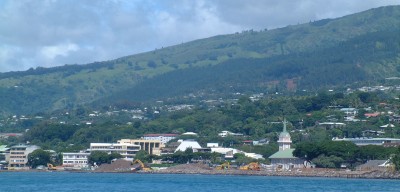 The Papeete waterfront and built-up hills behind it |
(Sue) What to say about a place I've dreamed of visiting for 20 years? I think my first impression was that the town of Papeete is a far cry from the small, romantic village that cruisers in the 1960's experienced. Yes, yachts still tie stern-to along the quay, but the waterfront is now overrun with noisy, smoggy traffic, and the reef bordering the pass to the north is a long dock of fuel storage containers. The prices of things are so high that we never even sat at a sidewalk cafe to enjoy a cold beer or a light lunch ... not at $18 for a piece of chicken and a bite if salad!
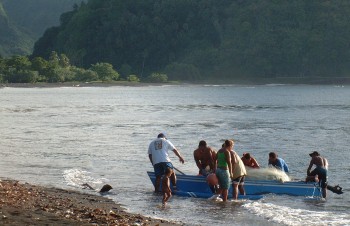 Tautira fishermen return to the beach in Tahiti-Iti |
Okay, I'll skip the negatives. Tahiti was great for grocery shopping
if you're starved for French food. The best part of the island is the interior (accessible by a very
exciting gravel road which fords the river often) and Tahiti-Iti, the small
peninsula to the southeast. Here the villages retain a feeling of South Pacific
paradise; there are fishing nets drying on the sandy beaches, the yards are
manicured and luxuriant, and the people friendly.
After visiting other parts of French
Polynesia which I loved, I can accept the reality of Papeete as the commercial
and political center, and be glad that its noise and hubbub are concentrated on
one island, and not spread throughout them all.
The Tahiti highlights for me were the days spent scuba
diving on the wrecks
and the outer reef, hiking the interior, and driving deep into the volcanic
hills. I also enjoyed seeing the Tahitian dancing at some of the tourist hotels
where we were welcome to watch, sitting apart from the restaurant patrons.
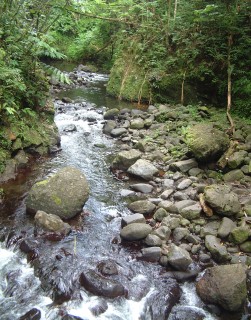 The lush Fautaua River valley is within walking distance of Papeete |
(Chris)
Tahiti is a large island, divided into two parts. Tahiti-iti, the smaller part
to the southeast, is mostly developed but not very citified. In fact, much of it
seemed to be agricultural. Even where not cultivated, Tahiti-iti did not seem
jungle-like, the way the interior of Tahiti-nui did.
Tahiti-nui's coastline, especially near Papeete, was quite
developed, with roads, hotels, bus stops, supermarkets, and so forth. However,
within walking distance of Papeete, the city turns first to small neighborhoods
and then to a path leading up a forested mountain. Mosquitoes aside, the path
was lovely, with a small river and lush forest. We took a long and lovely hike,
first walking past river occasionally large enough to swim in and then up a
mountain towards a gorgeous waterfall.
However, I was disappointed by internal Tahiti-nui when we
rented a car and drove inland. I was expecting a lush, jungle-like area such as
Dominica,
Martinique, or the
Marquesas. Instead, we were on muddy roads on
the sides of cliffs, looking over a wetland area where 4WD trucks with snorkels
would occasionally bring groups of tourists. Not a tour I wanted to be on.
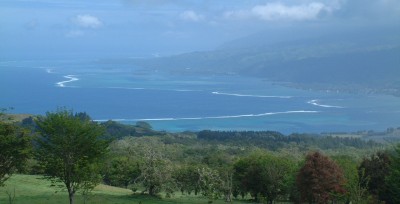 The extensive reefs and lagoons of southwest Tahiti |
Of course, my view of Tahiti-nui was probably colored by all the
construction we saw. Bridges were being built, dams (hydroelectric?) were under construction,
and roads were being laid across the island. This all resulted in ugly holes in
the ground, big piles of dirt, and lots of mud. Earthmoving machines and workers
aren't what we came to see, but if you sort of ignore them and the products of
their work, inland Tahiti is beautiful. In the distance (i.e. across the flooded
area) we could see green mountains and clear waterfalls.
I should also point out that Tahiti had some wonderful
diving.
The fish I saw were very interesting (my first lionfish here!) The wrecks were completely
different from any dive I'd done before, and even without
going inside (too dangerous) diving around a wrecked plane or ship is a lot of
fun. The diving we did in Tahiti was great enough to forgive a lot of construction.
Tahiti Diving | Marquesas Newsletters | Tuamotus Newsletters | FP Flora & Fauna
Top Level: Home | Destinations | Cruising Info | Underwater | Boat Guests | Ocelot | Sue | Jon | Amanda | Chris | Site Map | Make a Comment
|
If our information is useful, you can help by making a donation |
Copyright © 2000‑ Contact: Jon and Sue Hacking -- HackingFamily.com, svOcelot.com. All rights reserved.